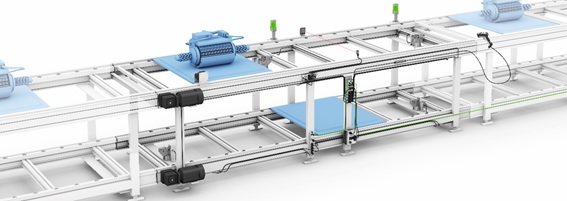Remote I/O products from Balluff, such as network blocks, IO-Link master and IO-Link hubs, are used in many production plants and by many technicians. So why remote I/O products are so popular in the market? Because it reduces downtime. In this blog, we would like to explain three reasons why our BNI just nails it.
Minimize control cabinet – Installation without any cover
Various devices such as PLC, inverters, power supplies, remote I/O and cables are crammed into the control cabinet. As automation becomes more popular, the number of devices increases in control cabinet. This, of course, drives up the costs of control cabinet, due to its bigger size. Many manufactures are facing the challenge of reducing the costs by minimizing the size of the control cabinet.
Remote I/O products from Balluff are designed with a high protection degree such as IP67 with robust metal housing or a light weight plastic housing. Therefore, these dust- and water-proof remote I/Os can be installed directly into the production field. As we have a version of switchable of input / output for each channel, you can integrate input and output on one version of our remote I/O. Thus, reduce the size and hardware configuration of PLC.
How many remote I/Os are in your control cabinet? Let’s consider how large of space in control cabinet is saved and how much cost can be saved by combining input and output remote I/O to one version and moving to outside of control cabinet.

No cover requirement- water and dust proof robust housing
Find failures in the field quickly– Visualization with big, bright LEDs
Customers sometimes inform us that Balluff's remote I/Os are a bit on the big. Indeed, the size of our remote I/O may not be fit the market's demand for small machines and equipment, This could be considered a challenge in the future, but there is a reason why these are at this size. It is because of visibility.
The remote I/Os from Balluff have individual large, highly visible LEDs for every channel. These LEDs indicate the various operating states of the connected sensors and actuators by three different colors and lighting conditions, such as on/off, short-circuit, overload or other faults. There are also LEDs for indicating power status and network communication status.
This means that when a fault occurs, these LEDs can immediately display the fault channel. This way you can save time and effort compared with the traditional way of searching the fault channel on a remote I/O with electrical drawing.
 Huge and bright LED for easy identify current status
Huge and bright LED for easy identify current status
No shutdown due to a short circuit - Short circuit / overload protection
Have you ever experienced a shutdown of power supply in control cabinet due to a short circuit caused by connected cables or overload caused by the actuator itself? One of our customers told me his experience. Since this trouble occurred before meeting the daily production plan, he had to working overtime. The customer searched short-circuit channels on remote I/Os in the control cabinet to localize failures with tester and electrical drawing. This restoration took more than 3 hours, he said.
The Balluff remote I/Os are equipped with short-circuit and overload protection on all channels. Therefore, if a short circuit or overload occurs, the connected power supply and other devices are not affected. Remote I/Os detect these short-circuit and overload faults and send a signal to the controller via field network. HMIs and LED stacked signal lights can instantly notify workers in the field of a fault.
As you can see, there is no need to put a tester on the remote I/O anymore. The remote I/O itself tells you the information you need to determine the cause and location of the failure. This feature, along with the LEDs per channel, allows you to recover more efficiently. Thus, saving you a great deal of time.

With these features and functions, you can see that Balluff's remote I/O can make a significant contribution to recovery for short-circuit and overload. But in order to do so, you need to do the following for remote I/O installation:
■ Install outside of control cabinet
■ Decentralize Installation near connected devices
■ Install it in a location that is easily visible from a distance, such as a pillar at the site or a wall of the equipment
If you adhere to above things, you will be able to recognize the location of the failure immediately in the field. This means you'll save a lot of time and the costs associated with sudden downtime.
Learn more about Balluff network modules here
Or take a detailed look at Balluff IO-Link hubs here
























